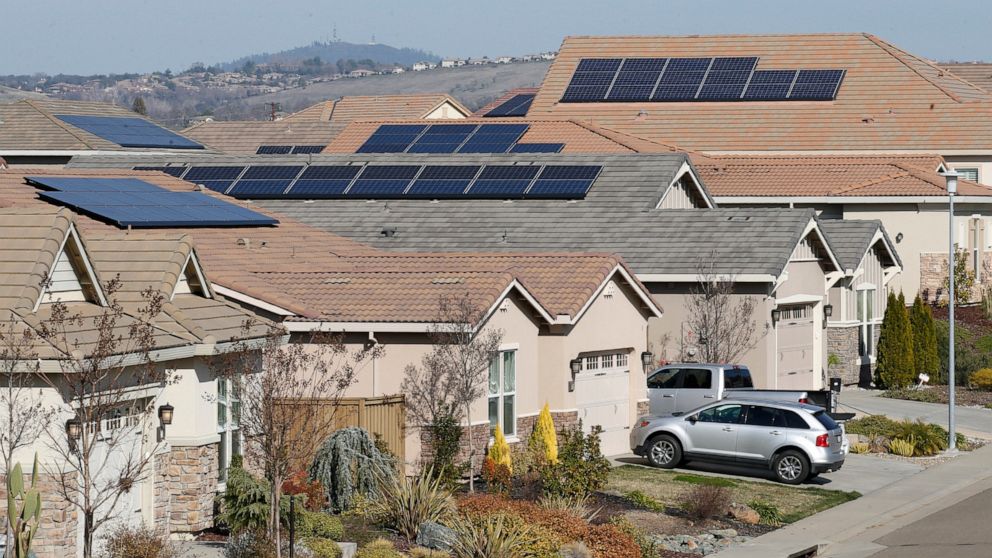California proposes reducing incentives for rooftop solar
Californians who decide to install home solar panels and storage systems would get lower discounts on their energy bills under a proposal released by state regulators that would lengthen to a decade the time it takes to recoup the costs of installation
December 14, 2021, 12:12 AM
6 min read
Share to FacebookShare to TwitterEmail this article
9:27
Meet the young innovator who thinks there's an answer for the nearly 300 million tons of waste America produces every year.
The Associated PressSACRAMENTO, Calif. -- California regulators proposed major changes to the state’s booming residential solar industry Monday, including reducing the discounts homeowners with rooftop solar and storage systems get on their electric bills when they sell extra energy back to the power companies.
California’s successful program to get more people to put solar panels on their homes has been at the center of a fierce debate between the state’s major utilities and the solar industry, and the California Public Utilities Commission’s proposed reforms have been highly anticipated.
The state's three major utilities — Pacific Gas & Electric, San Diego Gas & Electric, and Southern California Edison — say the savings solar customers get now are so great that those customers no longer pay their fair share for the operation of the overall energy grid.
The CPUC's proposal would reduce the incentives for going solar and roughly double, to 10 years, how long it takes Californians to make back what they paid to install the systems. Buying rooftop solar panels and a system to store extra power costs about $40,000, according to the solar industry.
The CPUC said the reforms are designed to make the program, known as “net energy metering,” more cost effective and to ensure energy grid operation costs are shared fairly. But the solar industry and its allies warned the changes will make it harder for the state to achieve its clean energy targets, including generating 100% of retail electricity from renewable or zero-carbon sources by 2045.
“The proposal will move us backward on clean energy and block many Californians’ ability to help make our grid more resilient to climate change,” Susannah Churchill, western senior regional director for Vote Solar, a political advocacy group that pushes for clean energy adoption.
California launched the program in 1995 with the goal of encouraging more homes to go solar. It worked. California now has 1.3 million solar systems on homes, far more than any other state, according to the solar industry. That number will only grow because since 2020 all newly constructed homes in California must have solar panels.
But as solar panels proliferated, and the cost of installing them went down, criticism of the program grew. The three major utilities say the current setup allows solar customers to sell their energy back into the grid for more than it’s worth. They say more needs to be done to make sure solar customers — most of whom still rely on power from utilities once the sun goes down — are paying for all the parts of the energy grid they use.
Power rates include many costs unrelated to energy generation, like transmission, distribution and even wildfire prevention work. When solar households pay significantly lower electricity bills — or no bills at all — they’re contributing less to those things. That means more of the cost is shouldered by other customers, often households and renters without the financial means to install solar.
The utilities and the state peg that cost at $3 billion. The solar industry disputes that number, saying it doesn't take into effect the savings for everyone when the utilities need to build fewer power plants and transmission lines due to more residential solar.
The CPUC’s proposal would still allow residential solar customers to sell their excess energy back to the power companies, but at a significantly lower rate. Solar customers would also have to pay a grid charge based on how many kilowatts of energy they produce; it would cost $40 to $50 for most homes.
The charges aren’t as great as what the utilities wanted. Pacific Gas & Electric spokeswoman Ari Vanrenen called the proposal a “step in the right direction to modernize California's outdated rooftop solar program.” But she indicated the utility — the state’s largest — would like to see regulators put higher charges on rooftop solar customers, but she declined to give specifics.







